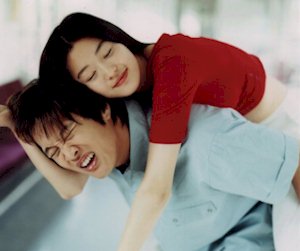“My Girl” by the Temptations was the last song I was expecting to hear: American music never plays in manga. Gyeon-woo prayed at the film’s start: “I want a relationship like the ones in the romantic comic books.” The 2001 Korean blockbuster, My Sassy Girl, was a living embodiment of romance comic: Gyeon-woo got his wish. Strangely reminiscent of the Love Hina manga series, this story mixes unrealistically comical situations, violence and love scenes. The appeal of My Sassy Girl is skin deep; no contemplation or deliberation is required. The movie wears its meaning on its sleeves.

The “funny” elements of the film are syphoned directly from the romance manga scene. This includes crude humor, sexual jokes, explicit female aggression and high school uniforms. However, Kwak Jae-yong — the film’s director — deviated from the usual romance formula. Jae-yong seemed to put focus on the reversal of gender roles: Gyeon-woo tells Sassy Girl’s blind date to never ask about her “femininity.” Gyeon was forced to wear heels as he ran though a park. Sassy Girl frequently showed courage and strength while the male role cowered in a corner. It is possible that the director meant to appeal the role of sexism in South Korean culture, but that is unlikely. This film is like medicine: take without thinking.
This movie targets an audience that pleads for cheap humor and a ridiculously improbable love story. The dry comedy reveals parts Korean humor, but the comedy’s global appeal takes away from Korean humor’s cultural identity. Most would laugh at the suggestive humor that powers Sassy Girl’s plot.
My Sassy Girl is a mindless love story that a global audience can appreciate. Afterall, we all need a break once in awhile.
http://www.youtube.com/watch?v=mZQCHWOM9bw